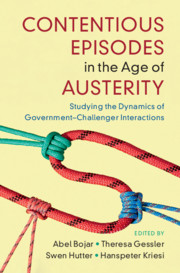 Contentious Episodes in the Age of Austerity
Contentious Episodes in the Age of Austerity from Part III - Dynamics of Interaction
Published online by Cambridge University Press: 05 November 2021
The previous chapters on interaction dynamics, the central aspect of the second part of this volume, have investigated the determinants of various action forms of the contending parties as a function of preceding action types or contextual features of the episodes. One particular feature of these dynamics, however, has remained unexplored. The flow of interaction between the contending parties does not proceed in a smooth, linear fashion – with one action triggering a reaction that in turn triggers a counter-reaction – as a stylized understanding of contentious politics might suggest. As we have shown earlier in Chapter 6 on the construction of action sequences, the empirical reality paints a more complex picture. While some actions indeed trigger one and only one further action and move the episode forward in that stylized fashion, others trigger two or more reactions, while still others put an end to a sequence and trigger no further actions at all. In other words, some actions have turned out to be considerably more consequential for the remaining part of the episode than others. Our first aim in this chapter is to highlight one type of such actions, in particular those with a heightened capacity to trigger an outstanding number of reactions, and seek to understand the regularities that characterize these actions. We shall refer to these actions as points of opening, inspired by the intuition that they open up contentious episodes to different threads of contention.
To save this book to your Kindle, first ensure [email protected] is added to your Approved Personal Document E-mail List under your Personal Document Settings on the Manage Your Content and Devices page of your Amazon account. Then enter the ‘name’ part of your Kindle email address below. Find out more about saving to your Kindle.
Note you can select to save to either the @free.kindle.com or @kindle.com variations. ‘@free.kindle.com’ emails are free but can only be saved to your device when it is connected to wi-fi. ‘@kindle.com’ emails can be delivered even when you are not connected to wi-fi, but note that service fees apply.
Find out more about the Kindle Personal Document Service.
To save content items to your account, please confirm that you agree to abide by our usage policies. If this is the first time you use this feature, you will be asked to authorise Cambridge Core to connect with your account. Find out more about saving content to Dropbox.
To save content items to your account, please confirm that you agree to abide by our usage policies. If this is the first time you use this feature, you will be asked to authorise Cambridge Core to connect with your account. Find out more about saving content to Google Drive.